Rankings
Course Rankings Analysis (2022-23 U.S. Edition)
Golf Digest came out with its first top course ranking back in the 1960s, and these lists have grown in popularity ever since. We think there are many factors for this, including the advent of social media, improved accessibility, and the general increase in popularity of golf travel. While there are three separate major U.S. publications that create annual or biannual course rankings, there is considerable overlap between the lists. We used our free website to take a deep dive into the 426 courses that make up the latest major U.S. publication lists: Golf Digest Top 200, Golf Magazine Top 100 and Second 100*, Golfweek Top 200 Classic and Golfweek Top 200 Modern. In this first edition of our rankings analysis, we’ll be breaking down these courses according to the following characteristics: course type, location, architecture, and tournaments hosted, as well as additional facts worth considering at the end. We hope this analysis provides interesting and valuable insights to the traveling golfer.
Course Info
Type
We categorize courses into 5 types, based on ownership and accessibility: Muni, Public, Resort, Semi-Private, and Private. Private courses dominated the aggregate list, with 333 out of 426 courses (78%). Resort courses did well, with the following establishments having multiple ranked courses: Bandon Dunes (5), Streamsong (3), Kohler (3), Forest Dunes (3), Pinehurst (2), Sand Valley (2), and Silvies Valley (2). The three Munis in the rankings were Bethpage (Black), Chambers Bay, and Torrey Pines (South).

Style
Golfweek was the only publication to include 9-hole courses in their rankings, with The Dunes Club, Sweetens Cove, Whitinsville, and Culver Academies included. All 426 courses were what characterize as Regulation (5,000+ yards for 18 holes or 2,500+ yards for 9 holes); however, with the increasing popularity of short courses (e.g. Par-3, Executive), it will be interesting to see if they start to make their way onto the lists in the coming years. Their popularity continues to grow and more and more of these projects are being built on world-class sites by the most skilled Architects.
Location
Region
For our analysis, we broke the country up into regions defined by the U.S. Bureau of Economic Analysis:
-
Great Lakes (IL, IN, MI, MN, OH, WI)
-
Mid-Atlantic (DE, DC, MD, PA, VA, WV)
-
New England (ME, MA, NH, RI, VT)
-
Pacific Northwest (AK, WA, OR)
-
Plains (IA, KS, MO, NE, ND, SD)
-
Rocky Mountain (CO, ID, MT, UT, WY)
-
Southeast (AL, AR, FL, GA, KY, LA, MS, NC, SC, TN)
-
Southwest (NM, OK, TX)
-
Tri-State (CT, NJ, NY)
-
Western-Pacific (AZ, CA, HI, NV
The Southeast led the way with 98 ranked courses, followed by the Great Lakes (75) and Tri-State (67) regions. The Southeast and Great Lakes also set the pace on the number of accessible courses (i.e. non Private). The Pacific Northwest region had the highest percentage of accessible ranked courses at 67%. On the other hand, New England and the Tri-State were the most exclusive, with only 4% and 6% of ranked courses being accessible.
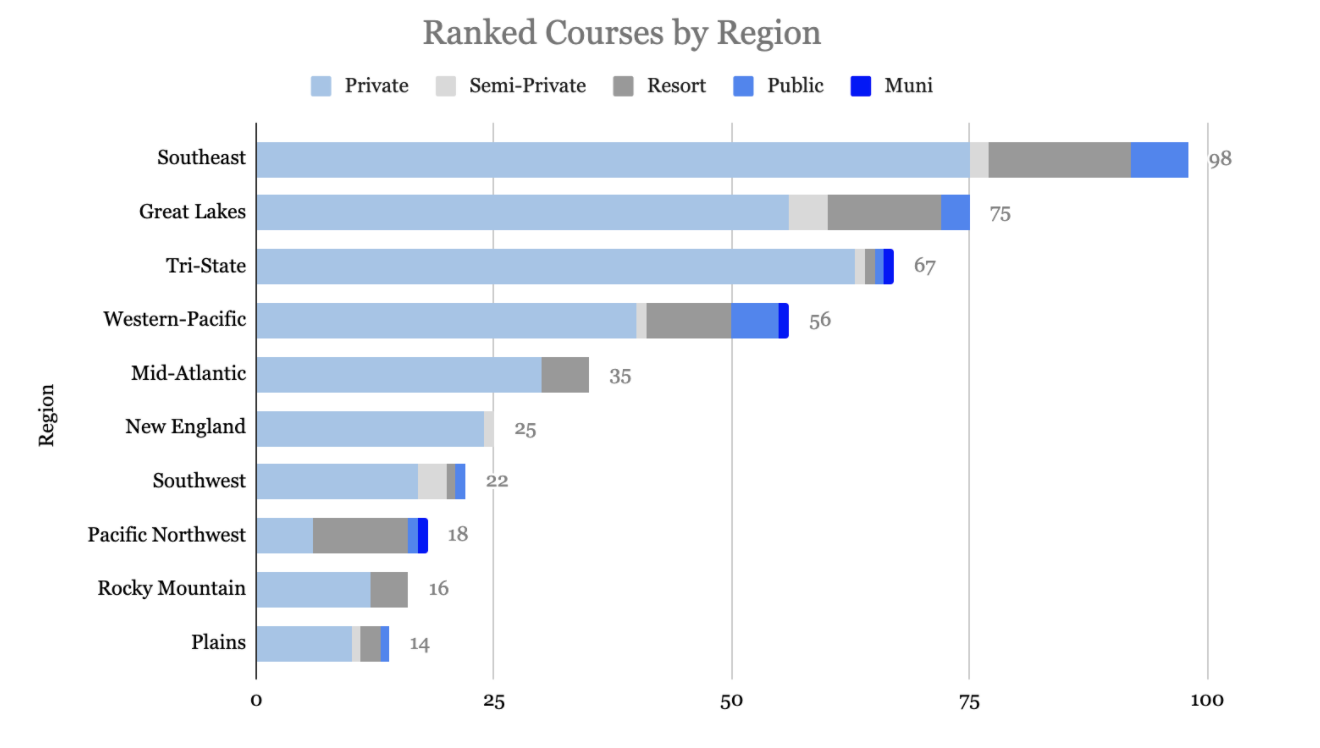
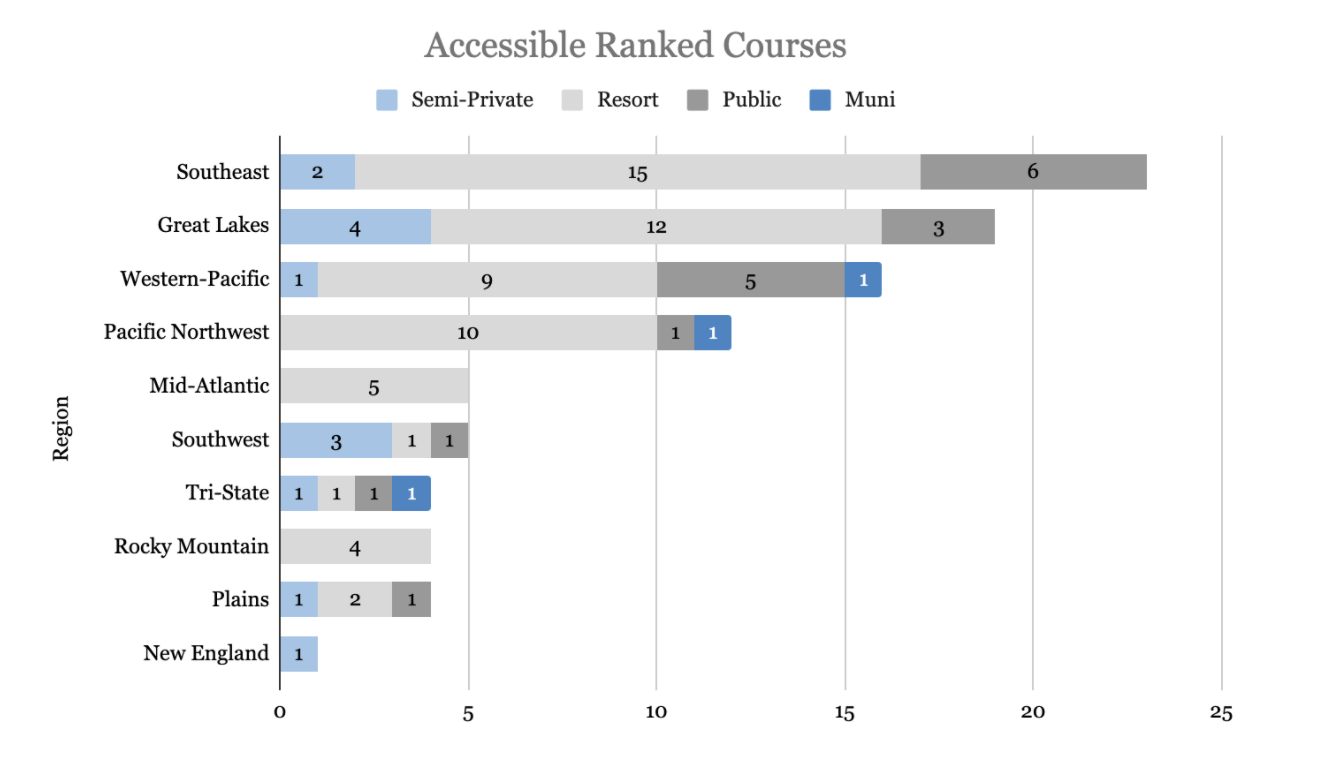
While this regional breakdown is interesting, logistically, the traveling golfer looking to plan a multi-day golf trip that includes as many ranked courses as possible might be best served by using the Open Links Regions, which are curated based on areas that make the most logistical sense for a multi-day golf trip. Here are the Open Links Regions with the most ranked courses:
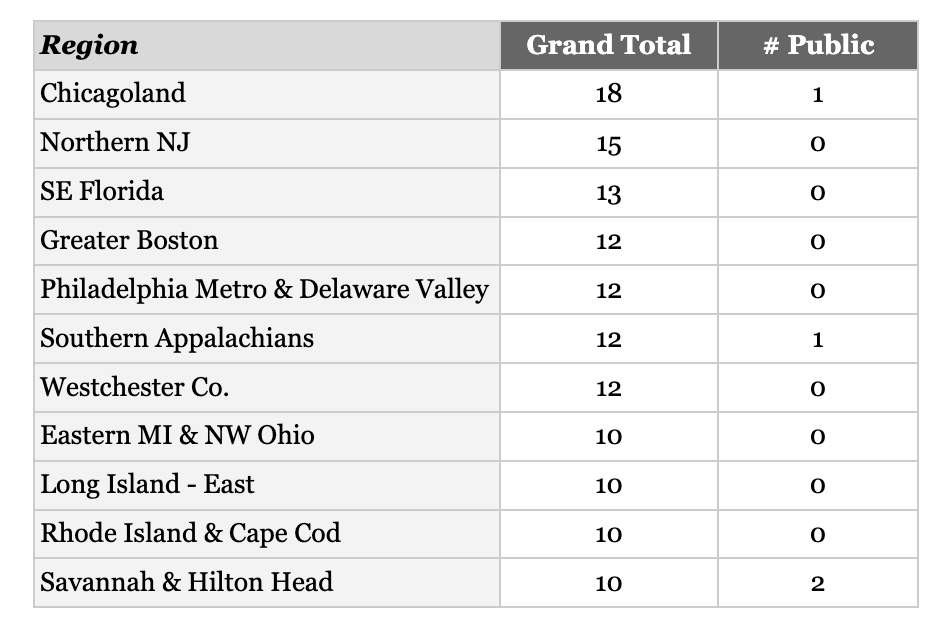
The size of the Open Links Regions vary, and the most concentrated region is Westchester County, with over 25% of the courses in our U.S. database being ranked. As you can see, one of the challenges is that most of these courses are private. The Open Links Regions with the most accessible courses are:
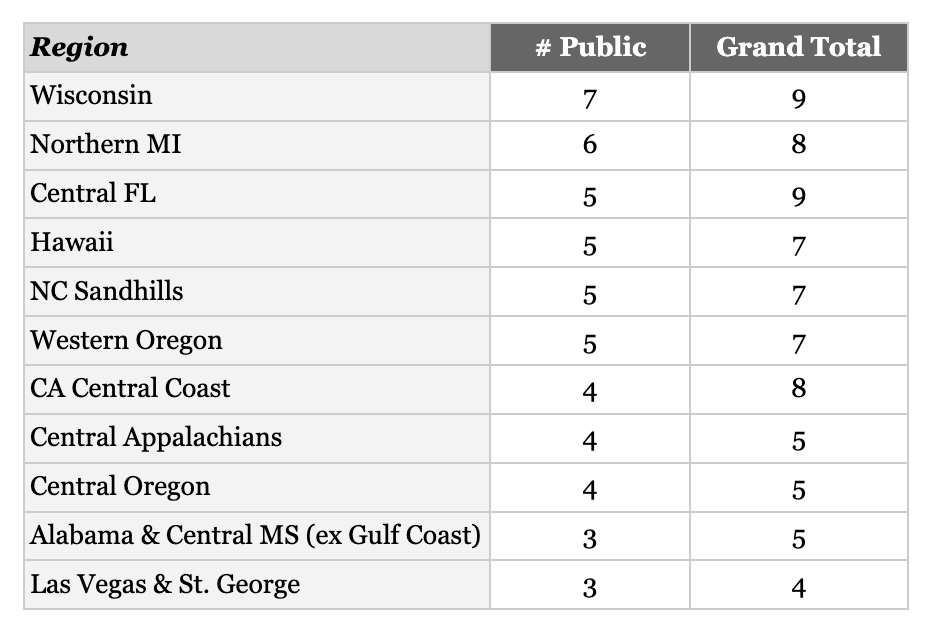
Below is a “heat map” of the Open Links Regions. The size of the circle is determined by the number of ranked courses in the Region whereas the color of the circle is determined by the accessibility of the ranked courses in the Region. The closer the Region is to 1 on the scale below, or 100% accessibility, the more green the circle of the Region will be.
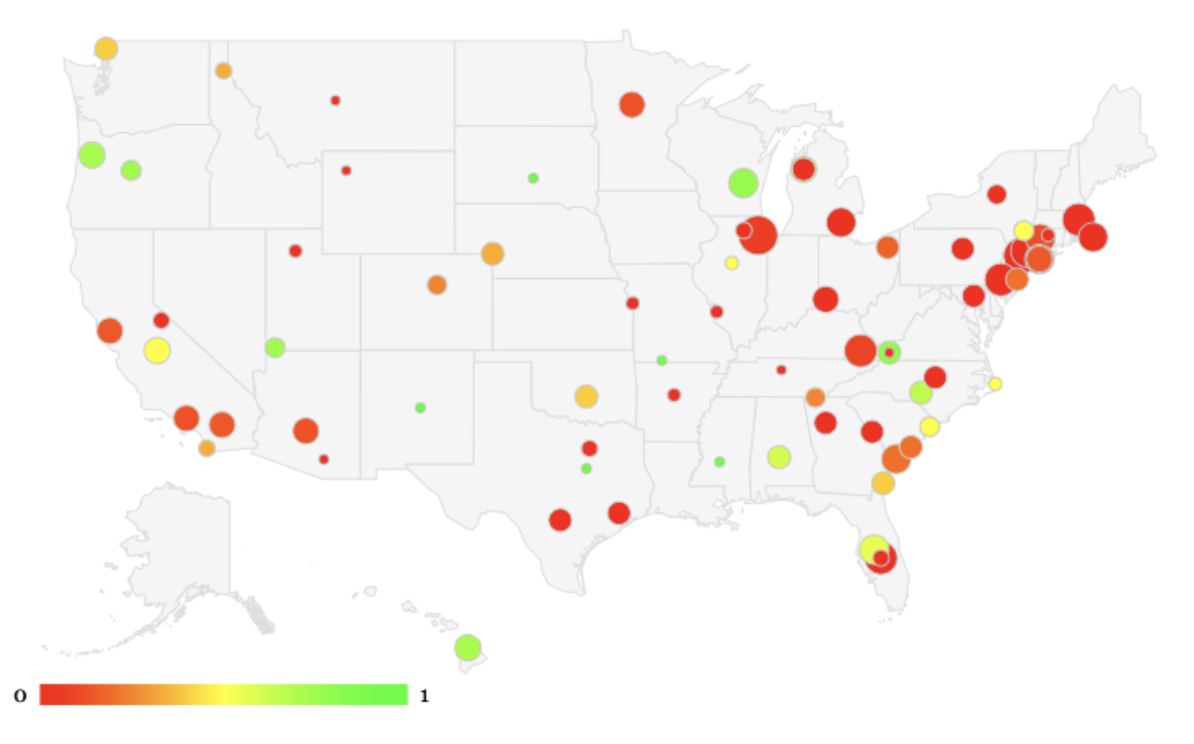
State
New York and California, the only states with more than 30 ranked courses, led all states by a pretty wide margin. California has made up ground on New York over the past few decades, however, with nearly 50% of its ranked courses being built since 1960. On the other hand, nearly 90% of the ranked courses in New York were built before 1960. It would not be surprising to see California take the overall lead in a future edition of our rankings analysis. We’ll dig more into the pre-1960 and post-1960 eras in the next section.
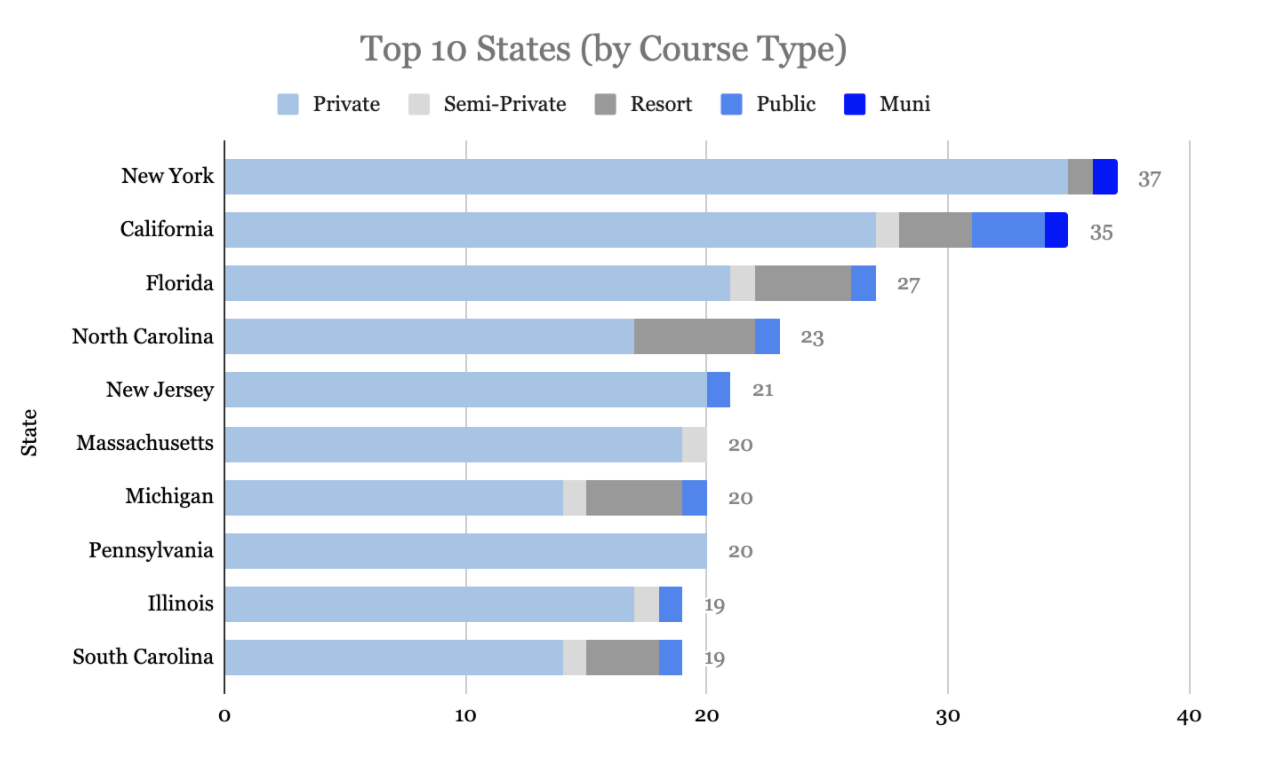
If one is looking to travel to a state with the most accessible courses, Oregon would be the top choice, followed by California and Wisconsin. Oregon and Wisconsin also offer a concentration of accessible ranked courses, with Bandon Dunes, Silvies Valley, Kohler and Sand Valley each offering at least 2 ranked courses.
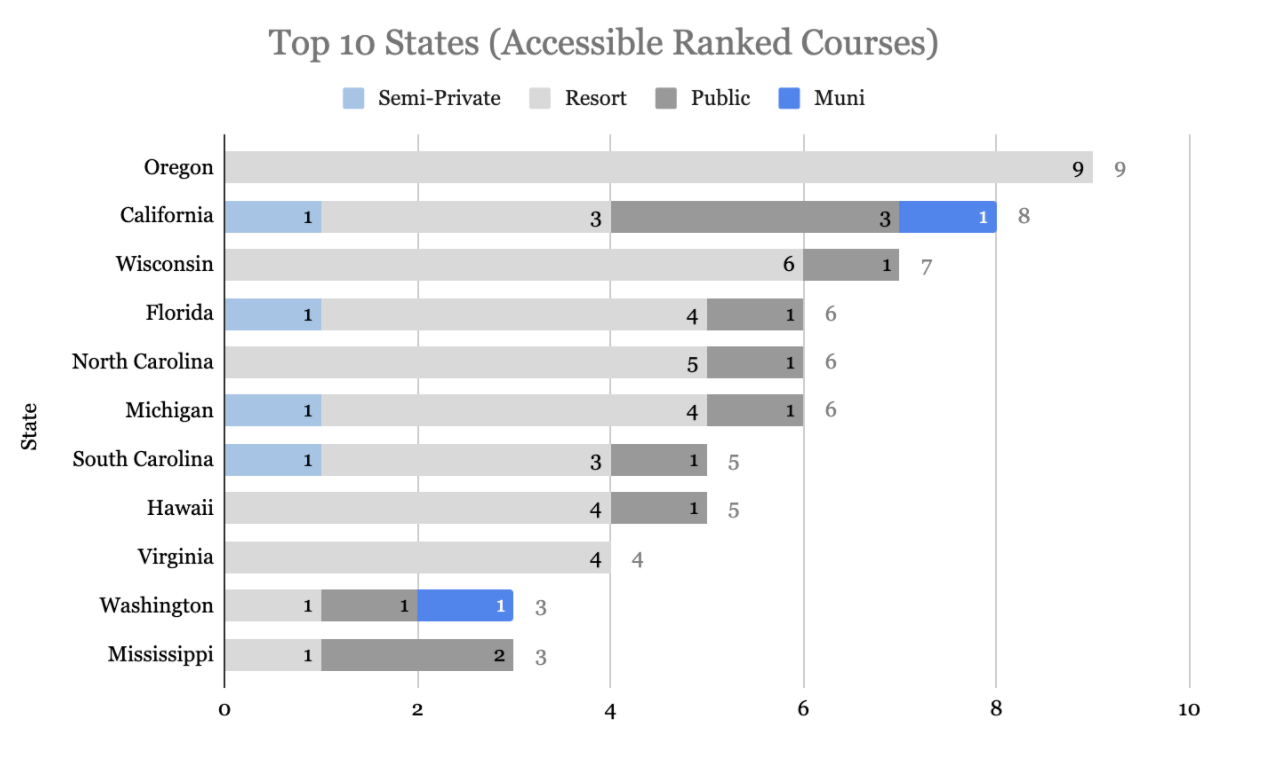
Architecture
Era/Decade
It was a bit surprising to see more ranked courses built after 1960 (Modern) than before 1960 (Classic). 53% of ranked courses were Modern and 47% were Classic. As you’ll see in the decades breakdown, there has been some serious momentum over the past 30 years in terms of new ranked courses being built.
There’s no question that the 1920s were “The Golden Age,” as that decade produced the most ranked courses (108); however the data indicates that the 2000s was something of a second golden age, with 94 ranked courses opening. The lowest decade was the 1940s (2 courses) followed by the 1970s (6). The 1940s gave us Peachtree and Dunes Golf & Beach Club and the 1970s gave us Butler National, Jupiter Hills (Hills), Makai (Princeville), Muirfield Village, Oak Tree National and Shoal Creek. We dive into Architects more in the next section but the rise of Pete Dye, Tom Fazio and Jack Nicklaus in the 1970s helped boost subsequent decades, particularly if you factor in their associates who went on to their own projects (e.g. Tom Doak and Bill Coore worked for Pete Dye, Mike Strantz and Dana Fry worked for Tom Fazio). The highest 30-year span was a tie between the 1910s to the 1930s and the 1990s to the 2010s, with 177 ranked courses each. The 1930s to the 1950s were the lowest 30-year span, with 31 ranked courses. The newest course in the rankings is the new Sheep Ranch at Bandon Dunes Resort, which was built in 2020.
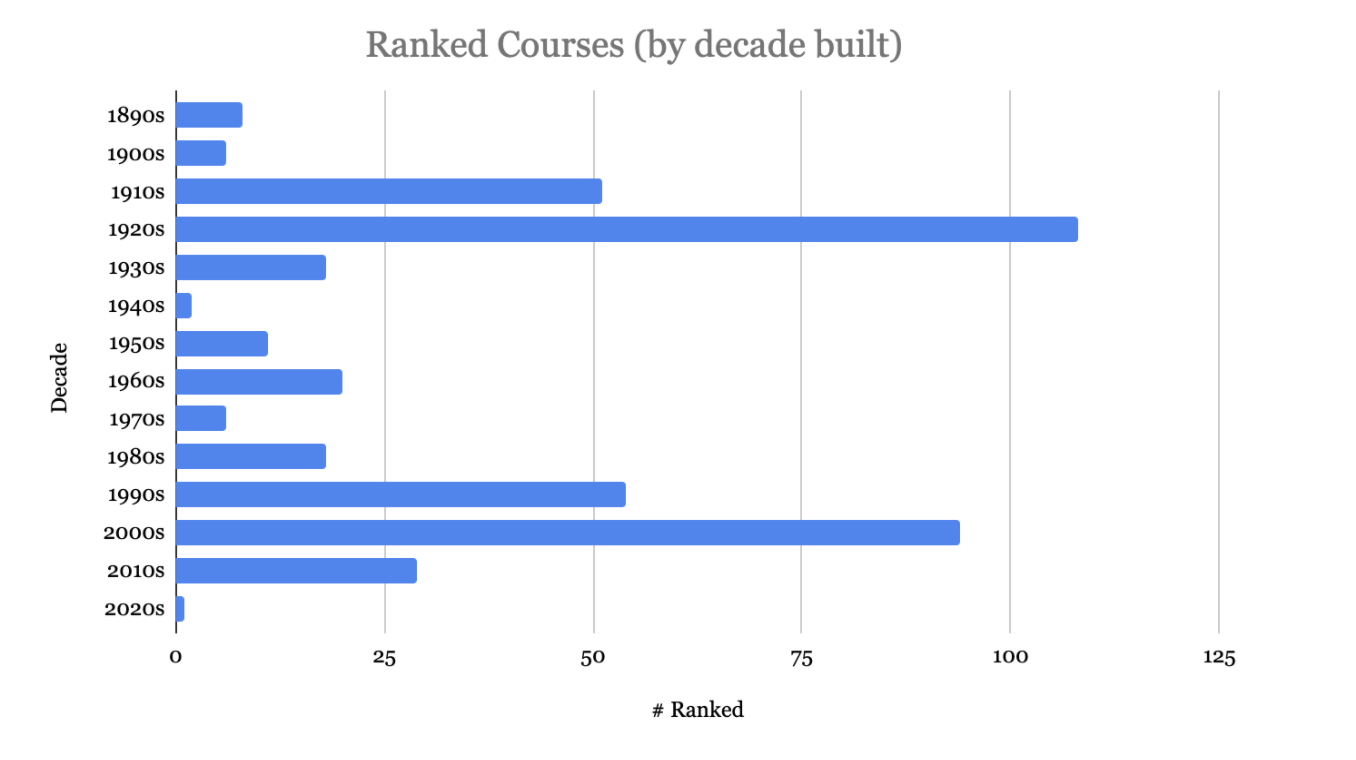
Architect
As far as original designs go, Donald Ross leads the way with 60 ranked courses in his portfolio, followed by Tom Fazio with 50. However, it’s worth noting that Ross has also designed the most courses of any architect in our database, so we also calculated the percentage of courses designed that are ranked, our architect Batting Average. If you believe the rankings have merit, this statistic could be viewed as a quality measure. When looking through this lens for architects who have built at least 20 new courses, the duo of Bill Coore & Ben Crenshaw lead the way with a Batting Average of .720, followed by Tom Doak (.625). As far as Architects who built their courses in the Classic Era (i.e. prior to 1960), Seth Raynor and C.H. Alison led the way at 0.400. It is worth noting that C.B. Macdonald had the highest batting average (0.778) of any architect in our database and David McLay Kidd was tied for 3rd (0.625); however, neither met the 20 course minimum for this particular analysis.
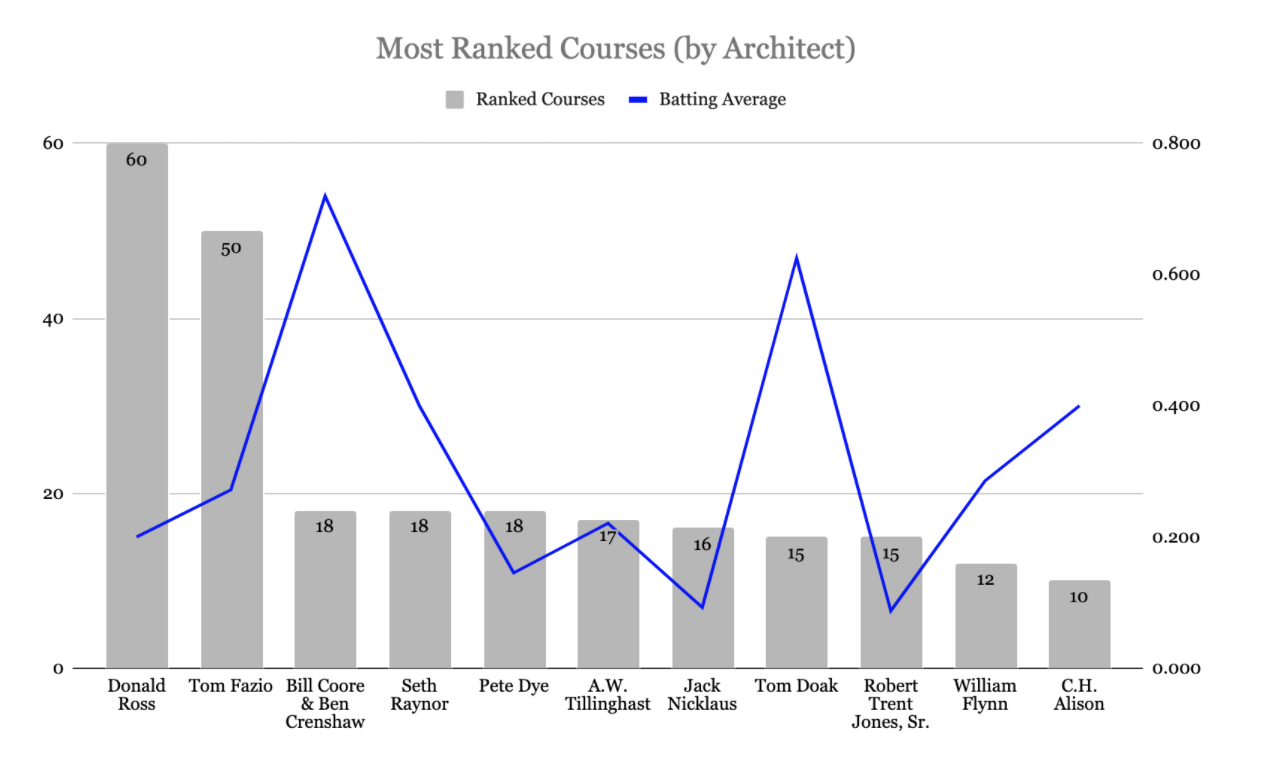
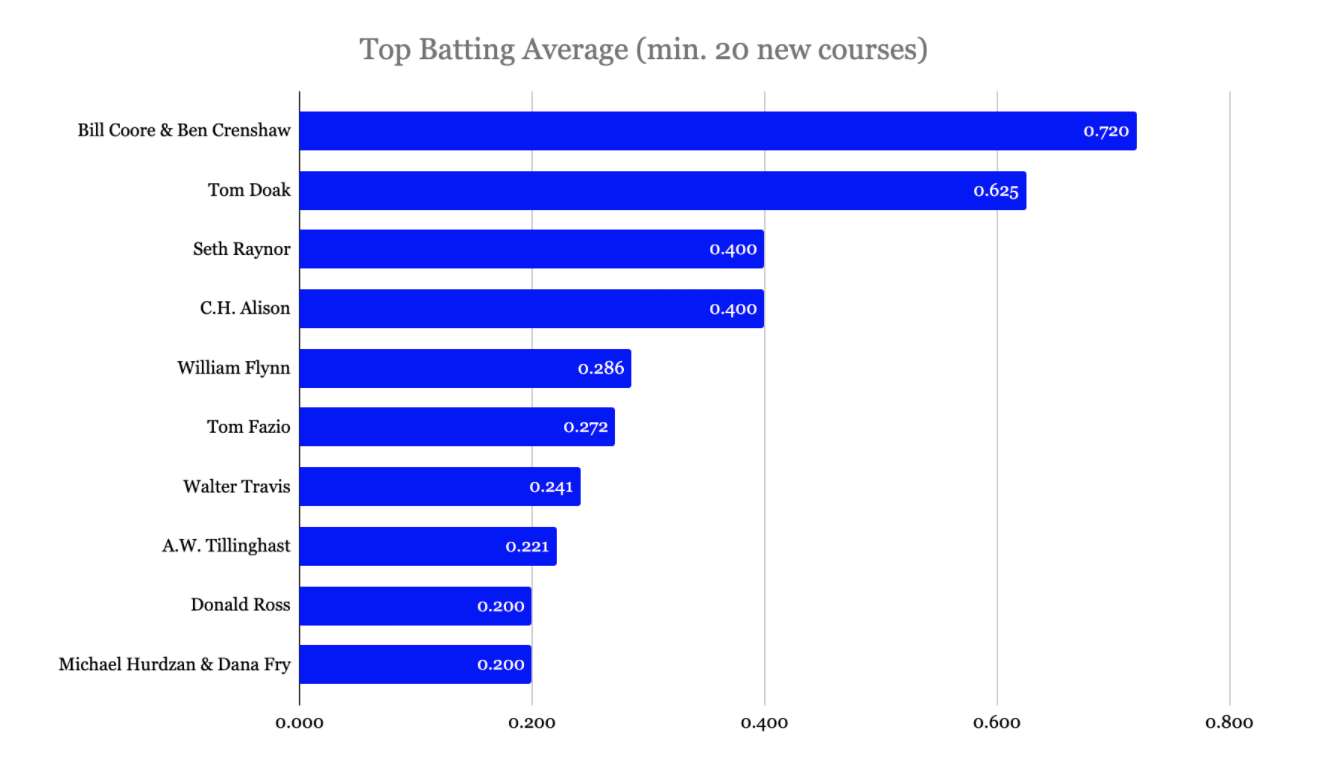
While the breakdowns above are for original designs, we also collect data on the architect who has most recently worked on a course (dating back to 1990), whether it be a renovation, restoration, or combination of both. When tracked according to this metric, Tom Fazio & Co. lead the way with 33, followed by Gil Hanse (25) and Ron Forse (21). Hanse looks to be closing the gap fast, however. He has worked on 9 ranked courses in the past 5 years and has some big projects in the pipeline, including Yale, Olympic Club (Lake), The Honors Course, Colonial CC, Lake Merced and Baltusrol (Upper). Rees Jones leads the way with recent work to ranked courses that are accessible with six courses: Mauna Kea, Bethpage (Black), Cog Hill (#4 Dubsdread), Dunes Golf & Beach Club, Torrey Pines (South) and Golden Horseshoe (Gold). We also started collecting data on golf course construction companies that perform renovations and, while the data set is still a work in progress, Labar Golf Renovations leads the way so far, followed by Medalist Golf. We hope to have more specific breakdowns on golf course construction companies in the next edition of the rankings analysis.
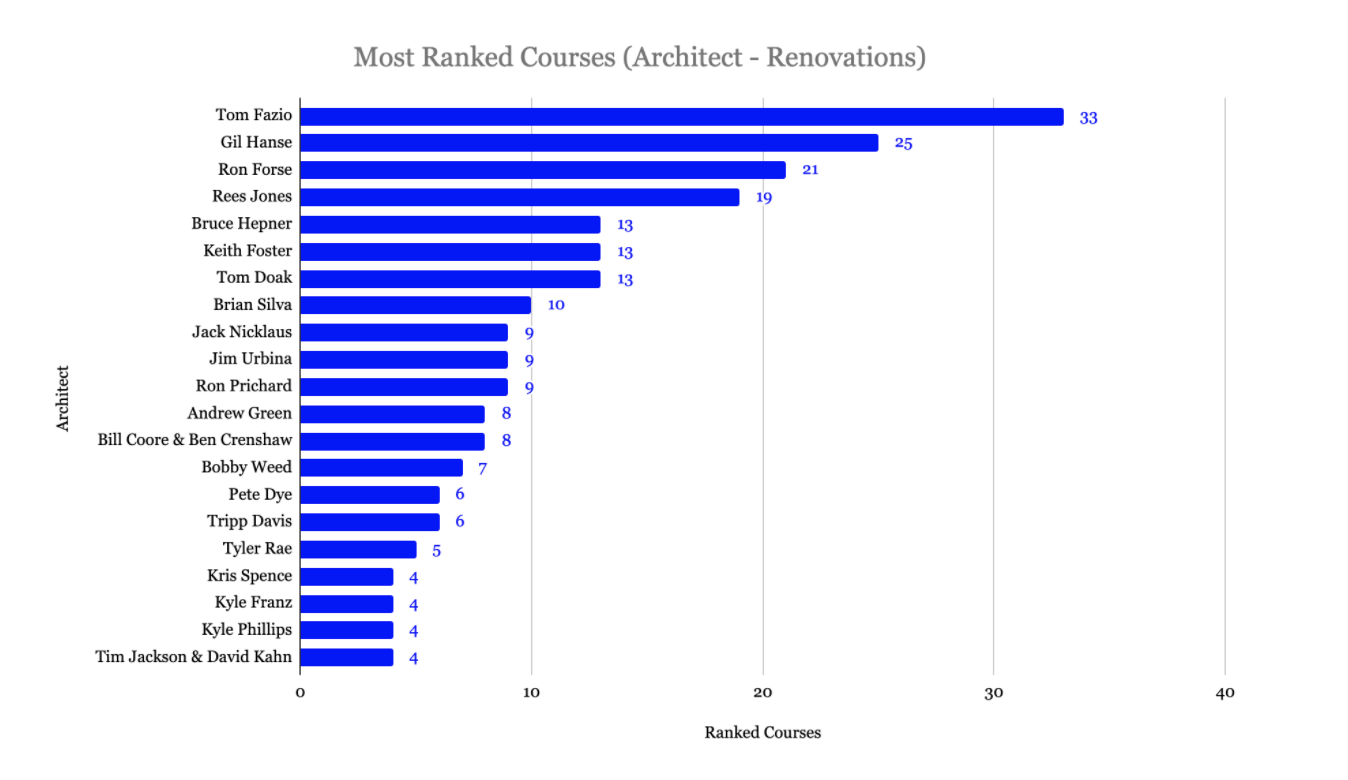
Tournaments
USGA
Roughly 40% of ranked courses have hosted a USGA event, with Merion leading the way at 19 events, followed closely by Oakmont (17) and The Country Club (16). Oakmont has been making up ground on Merion over the past few decades and will likely take the lead in the future, with 4 U.S. Opens scheduled (2025, 2034, 2042, and 2049) compared to 2 for Merion (2030, 2050). Pinehurst No.2 is another venue to keep an eye on and will continue to move up the USGA rankings over time. Just last year, the USGA announced that Pinehurst would be their first “anchor site” and will host 5 U.S. Opens between now and 2047, not to mention several other USGA events. It is also interesting to note that the top-10 on this list are all Classic (i.e. built before 1960) courses. The Modern courses, i.e. built after 1960, that have hosted the most USGA events are Hazeltine (8), Crooked Stick (6), Eugene CC (5), The Honors Course (5), Atlanta Athletic Club Highlands (4), Cog Hill (#4 Dubsdread) (4), and Bandon Dunes (4).
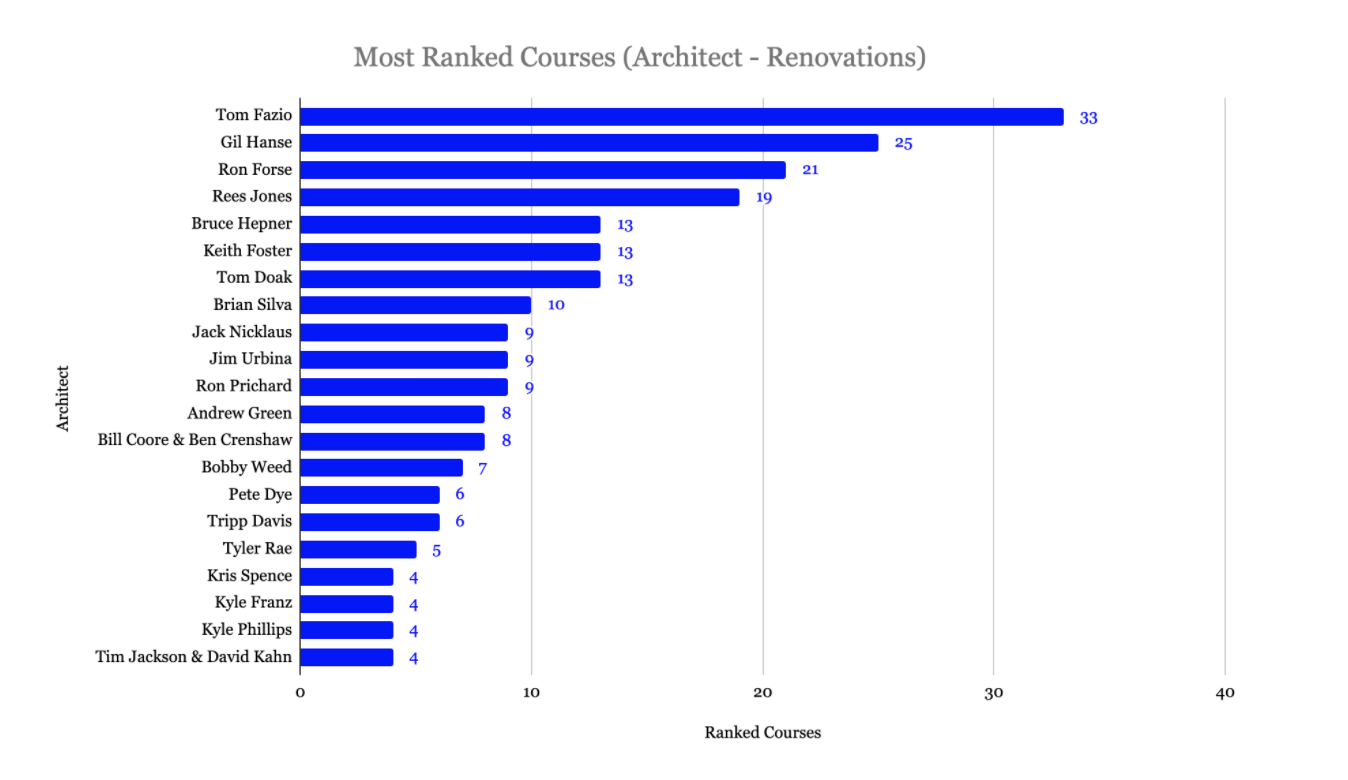
Men’s Professional Majors
Augusta National hosts the annual Masters Tournament, so it’s no surprise that this course leads the way as far as most men’s professional major events hosted, with 83. However, if we remove Augusta, the list looks like the following:
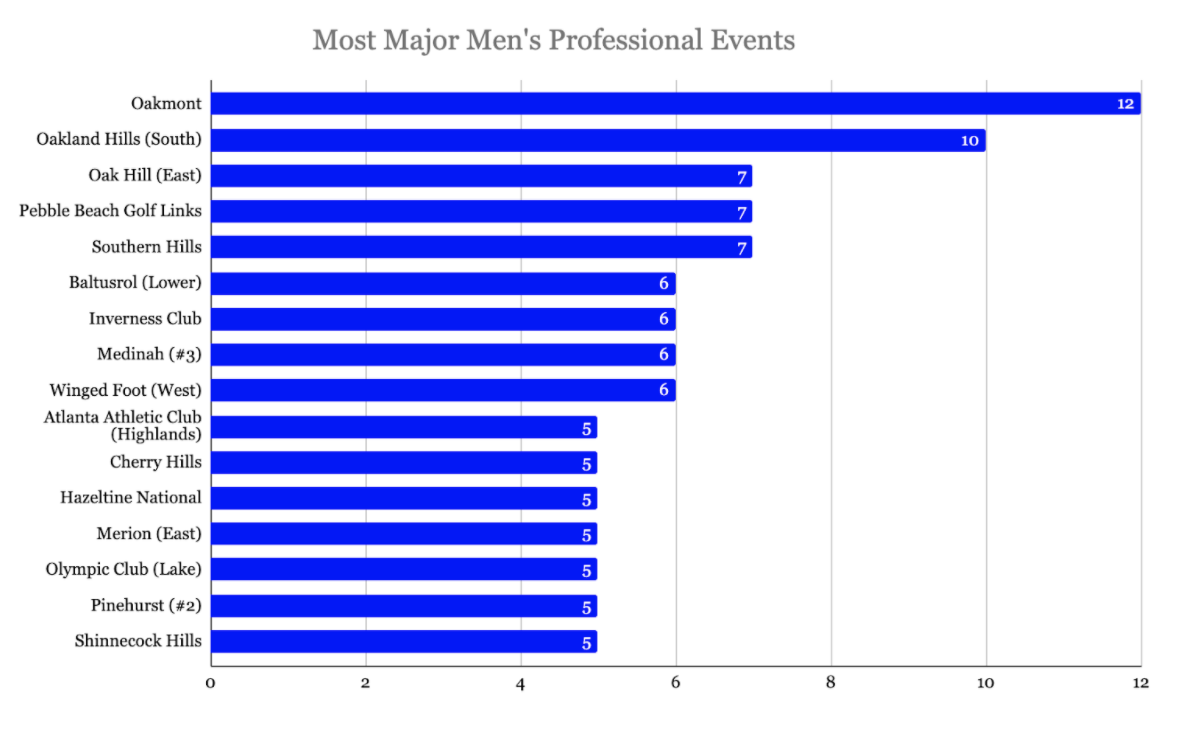
Women’s Professional Majors
Women’s professional major event host venues are not as concentrated as the Men’s venues, outside of Augusta Country Club, which hosted the Titleholders Championship each year from 1937 to 1966 and leads the way. If we control for this outlier a second time, Pine Needles has hosted the most Women’s Majors with 4 events.
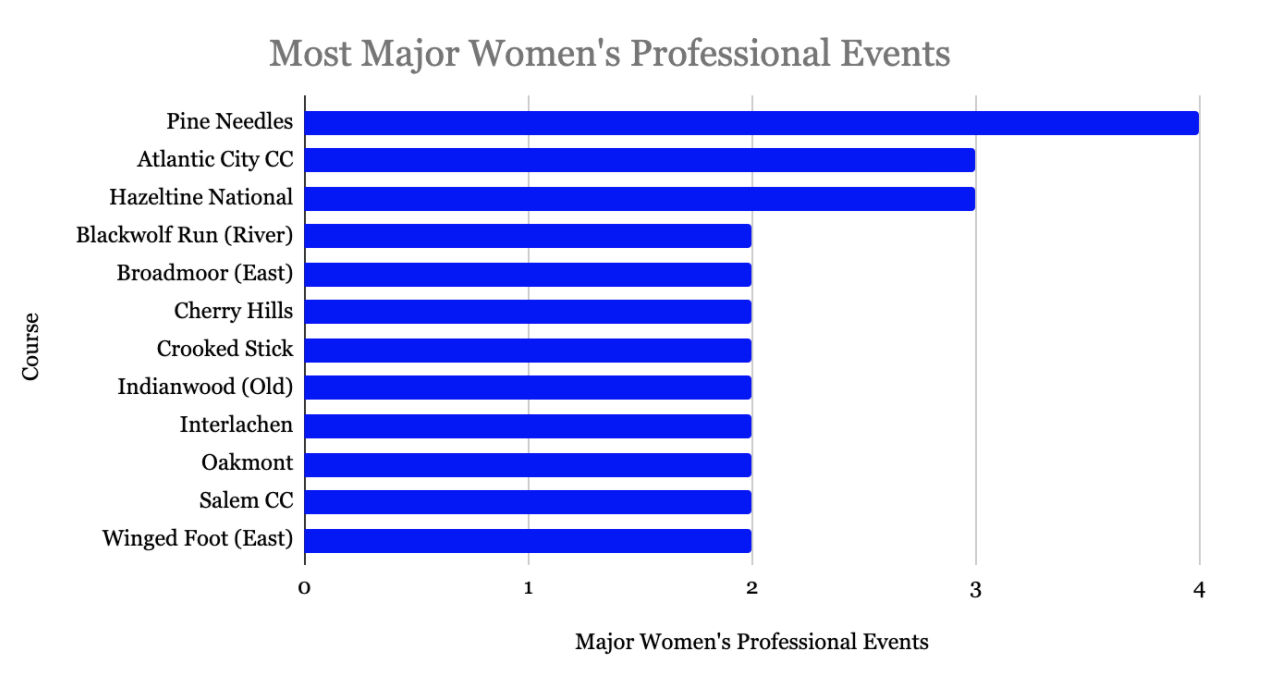
Additional Factors Worth Considering
-
French Lick Dye was the longest 18-hole course (8,102 yards) and Misquamicut was the shortest (6,214). The overall shortest course across the rankings was 9-hole Whitinsville (3,124 yards)
-
The ranked courses at the highest elevation** were Forest Highlands Canyon (6,929 feet), Paa-Ko Ridge (6,690), Glenwild (6,673), Broadmoor West (6,581), Broadmoor East (6,437), and Martis Camp (6,381)
-
Three 18-hole courses had a sub-70 par: Misquamicut (69), CC of Waterbury (69), and Wannamoisett (69)
-
The top-5 highest Course Ratings*** (18 holes, from the back tees) are Blessings GC (80.9), French Lick Dye (80), Rich Harvest Farms (79.8), Congaree (79.4), Oak Tree National (79.2), and Kiawah Ocean (79.1)
-
The top-5 lowest Course Ratings*** (18 holes, from the back tees) are Roaring Gap (69.6), Misquamicut (70.2), Southampton (71), CC of Fairfield (71), Leatherstocking (71)
-
There are 16 ranked courses with a maximum Slope Rating*** from the back tees, including Pine Valley, Pikewood National, TPC Sawgrass, Bethpage Black, and Kiawah Island (River)
-
The ranked courses with the lowest Slope Rating*** from the back tees are Gamble Sands (120) and Bandon Dunes Sheep Ranch (122)
-
~60% of ranked courses had Bent grass greens (or some combo of Bent) with Bermuda being the second most popular with ~20%
-
31 ranked courses (8%) were located on an ocean or very large body of water (e.g. Great Lakes)
-
The average Max Fee of Public courses was the lowest of the different Course Types, at $174. Munis followed that at $225 and Resorts and Semi-Privates were the most expensive, both just above $300
-
Parkland was the most common Terrain/Landscape with 55%, followed by Woodland (15%), Grassland/Open (15%), Desert (5%) and Mountain (5%)
-
~70% of ranked courses have a Caddie program
-
Six ranked courses are part of men-only clubs: Black Sheep, Bob O’Link, Butler National, Garden City, Old Elm and The Golf Club
-
The busiest ranked course was Torrey Pines (South), which has on average 70,000 rounds played per year. Canyata was the least busy course with only 150 rounds played per year
-
According to our Walkability** data, the 5 hardest walks are Cascata, Manele, Black Jack’s Crossing, Farmlinks at Pursell Farms and Kapalua Plantation. The 5 easiest walks (18 hole courses) are CC of Fairfield, Southampton, Wannamoisett, Hyannisport and White Bear Yacht Club
-
20% of ranked courses offer a short course (e.g. Par-3, Executive, Putting, Pitch n’ Putt) on property, and 33% offer lodging onsite
-
Casinos are associated with the following ranked courses: Atlantic City CC, We-Ko-Pa Saguaro, Greenbrier Old White, Fallen Oak, Shadow Creek, French Lick Dye, and Cascata
-
Average number of bunkers was 88 (we removed outlier Whistling Straits and its 1,012 (!) bunkers)
